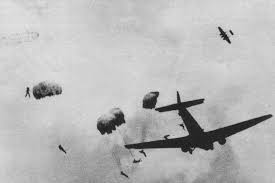
The Battle for The Hague took place on 10 May 1940 as part of the Battle of the Netherlands between the Royal Netherlands Army and Luftwaffe Fallschirmjäger (paratroops). German paratroopers dropped in and around The Hague in order to capture Dutch airfields and the city.

After taking the city, the plan was to force the Dutch queen Wilhelmina of the Netherlands to surrender and to thus defeat the Kingdom of the Netherlands within a single day. The operation failed to capture the Queen, and the German forces failed to hold on to the airfields after Dutch counterattacks. The main body of surviving troops under Von Sponeck retreated toward the nearby dunes where they were continually pursued and harassed by Dutch troops until the Dutch supreme command, due to major setbacks on other fronts, surrendered five days later.

A German airfleet crossed The Netherlands under cover of darkness and, once over the North Sea, headed back towards the Dutch coast aiming for The Hague, the Dutch seat of government.
Surrounded by fighters and fighter-bombers, a large number of Junkers 52/3m transports carried the 5.000 men of the German 22nd Airborne Division.

The audacious objective of this unprecedented massive airborne operation was to seize the three airfields surrounding the city, arrest the Dutch government and capture the Dutch Royal family in their residency.
Attacks on Dutch airfields began at 04.15 and despite the alarm that had gone out around 03.00 (when the German airfleet had crossed the border) many Dutch fighters and bombers were damaged or destroyed on the ground..
The Germans planned to surprise the Dutch and so catch them off guard, allowing them to isolate the head of the Dutch Army. It was their intention to fly over the Netherlands, in order to lull the Dutch into thinking that England was their target. This was to be followed by approaching the country from the direction of the North Sea, attacking the airfields at Ypenburg, Ockenburg and Valkenburg to weaken potential Dutch defenses before taking The Hague. It was expected that the queen and the commander in chief of the Dutch forces, Henri Winkelman, might agree at this point to surrender.

However, if the Dutch did not surrender, the Germans planned to cut off all roads leading to The Hague in order to quell any subsequent Dutch counter-attack.
Although the German troops managed to capture the three airfields, they failed in their primary objective of taking the city of Hague and forcing the Dutch to surrender. Accordingly, the Dutch Army launched a counter-attack several hours later
The counter-attack was started from Ypenburg. Though outnumbered and relying on ammunition that they had captured from the Germans, the Dutch Grenadier Guards fought their way into position to launch artillery attacks against their own airfield, causing heavy damage to it. Following the attacks, the German troops were forced to evacuate the airfield’s burning buildings, losing their strong defensive position. The Dutch troops were able to advance into the airfield, and in the skirmishes that followed, many of the German soldiers were forced to surrender. Those who did not were eventually defeated.
Four Dutch Fokker T.Vs bombed the Ockenburg airfield,

destroying idle Ju-52 transports.

The Dutch troops followed up by storming the airfield. The Germans were forced into retreat, and several were captured. However, some of the German troops withdrew to the woods near the field and successfully defended themselves against the counter-attack. The Dutch forces were later ordered to disengage and turn instead to Loosduinen, and so the Germans were able to head towards Rotterdam.
Having sealed off Leiden and the village of Wassenaar, the Dutch retook an important bridge near Valkenburg. When reinforcements arrived, the Dutch began attacking the Germans on the ground at the same time when Dutch bombers destroyed the grounded transport planes. While the Germans put up a defence at the outskirts of the airfield, they were forced to evacuate under heavy fire. Several skirmishes to liberate occupied positions in the village of Valkenburg nearby were fought between small groups of men on both sides, the Dutch with artillery support from nearby Oegstgeest, the village being heavily damaged in the process.
By the end of 10 May, Dutch forces had retaken the captured airfields, but this tactical victory was to be short lived as on 14th May the German Rotterdam Blitz forced the Dutch armed forces to surrender.

You must be logged in to post a comment.